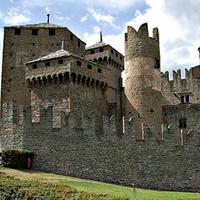8. Quali armi venivano usate?
8. Welche Waffen wurden verwendet?
8. What weapons were used?
8. Que armas foram utilizadas?
8. Vilka vapen användes?
I soldati ordinari usavano qualsiasi cosa, dai sassi ai cannoni.
|||they used|any|||stones||cannons
Ordinary soldiers used everything from stones to guns.
Zwykli żołnierze używali wszystkiego, od kamieni po broń.
Un sasso era un'ottima arma se fatta cadere sulla testa di qualcuno dal corpo di guardia del castello, in tutta sicurezza.
|stone||||||to fall|||||||||||||
A stone was an excellent weapon if dropped on someone's head from the castle guardhouse, safely.
Kamień był doskonałą bronią, gdyby ktoś bezpiecznie spadł na głowę kogoś z wartowni zamkowej.
Cannoni veri e propri non furono comuni fino al XV secolo.
Real cannons were not common until the 15th century.
Prawdziwe armaty nie były powszechne aż do XV wieku.
Pistole non ne avevano realmente.
Guns didn't really have any.
Pistolety tak naprawdę ich nie miały.
C'erano pochi tipi di pistole molto semplici usate intorno al 1320.
||||||||around|
There were a few very simple types of pistols used around 1320.
Było kilka bardzo prostych typów pistoletów używanych około 1320 roku.
Erano praticamente inutili; non si poteva sparare con precisione e potevano facilmente ferire la persona che le adoperava.
||useless||||to shoot|||||||||||he used
They were practically useless; they could not be fired accurately and could easily injure the person using them.
Były praktycznie bezużyteczne; nie mogły być celnie wystrzelone i mogły łatwo zranić osobę, która z nich korzystała.
Così l'idea non si diffuse.
||||it spread
So the idea didn't spread.
Więc pomysł się nie rozprzestrzenił.
Le frecce lanciate dagli archi servivano di più per colpire i bersagli a lunga distanza.
the||you launched|||they served||||||targets|||
The arrows fired from the bows were used more to hit targets at long range.
Strzały wystrzeliwane z łuków były używane częściej do trafienia celów z dużej odległości.
Per tale motivo erano molto più popolari e comuni.
|such|||||||
For this reason they were much more popular and common.
Z tego powodu były znacznie bardziej popularne i powszechne.
Le frecce e gli archi solitamente venivano usate da semplici soldati, non cavalieri.
Arrows and bows were usually used by ordinary soldiers, not knights.
Strzały i łuki były zwykle używane przez zwykłych żołnierzy, a nie rycerzy.
Vi erano due tipi di archi: gli archi lunghi, cioè archi a curvatura lunga, e le balestre.
||||||||||||curvature||||crossbows
There were two types of bows: long bows, that is, long-curved bows, and crossbows.
Istniały dwa rodzaje łuków: łuki długie, czyli łuki o długim łuku, oraz kusze.
Le armi più importanti dei cavalieri erano le spade, le lance e le mazze chiodate o “stelle del mattino”, che erano simili a un bastone in cima al quale si trovava una corta catena attaccata a una palla di metallo, ricoperta di punte di chiodi.
|||||||||||||clubs|spiked||||||||||||top||||||short|||||ball|||covered||||nails
The most important weapons of the knights were swords, spears and spiked clubs or "morning stars", which were similar to a stick on top of which there was a short chain attached to a metal ball, covered with spikes of nails .
Najważniejszą bronią rycerzy były miecze, włócznie i kolczaste maczugi lub „gwiazdy poranne”, które przypominały laskę, na której szczycie znajdował się krótki łańcuszek przymocowany do metalowej kuli, pokryty szpikulcami.
Il cavaliere che la adoperava doveva afferrare il bastone, far oscillare la catena attorno così che la palla di chiodi poteva colpire il nemico.
||||||to grasp||||to swing|||||||||nails||||
The knight who used it had to grab the staff, swing the chain around so that the ball of nails could hit the enemy.
Rycerz, który go użył, musiał chwycić laskę, obrócić łańcuch tak, aby kula gwoździ mogła trafić wroga.
Quando si utilizzava un arco lungo, la freccia poteva raggiungere una distanza molto superiore rispetto a quella lanciata da chi usava una balestra.
|||||||arrow||||||||||launched|||||crossbow
When using a longbow, the arrow could reach a much greater distance than that launched by someone using a crossbow.
Używając długiego łuku, strzała mogła osiągnąć znacznie większą odległość niż ta wystrzelona przez kogoś używającego kuszy.
Tuttavia la freccia della balestra era molto più veloce.
However, the crossbow arrow was much faster.
Jednak strzała z kuszy była znacznie szybsza.
A quel tempo non esistevano ancora i carri armati e i soldati medioevali usavano le torri d'assedio.
|||||||tanks||||||||towers|of siege
At that time there were still no tanks and medieval soldiers used siege towers.
W tym czasie nie było jeszcze czołgów, a średniowieczni żołnierze korzystali z wież oblężniczych.
Si trattava di una macchina da guerra molto grande che veniva utilizzata per raggiungere le mura difensive di una città o fortezza.
|it concerned||||||||||||||||||||
It was a very large war machine that was used to reach the defensive walls of a city or fortress.
Była to bardzo duża machina wojenna, która służyła do dotarcia do murów obronnych miasta lub twierdzy.
Era fatta di legno, piena di soldati armati che la trasportavano su delle ruote fino sotto i muri di un castello.
|||||||||||||wheels|||||||
It was made of wood, full of armed soldiers who carried it on wheels to the walls of a castle.
Wykonany był z drewna, pełen uzbrojonych żołnierzy, którzy wnieśli go na kołach pod mury zamku.

